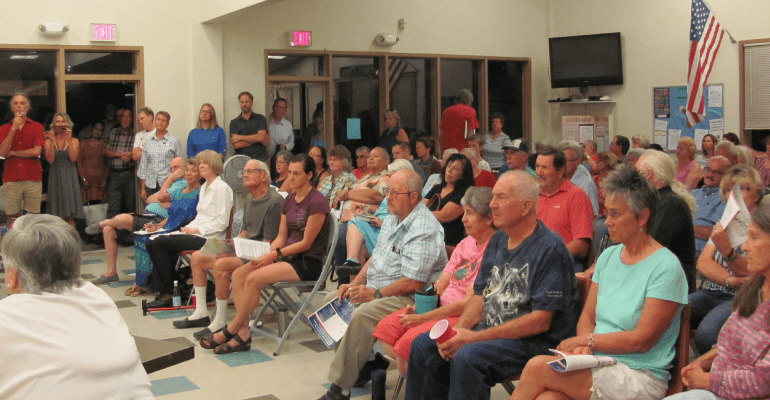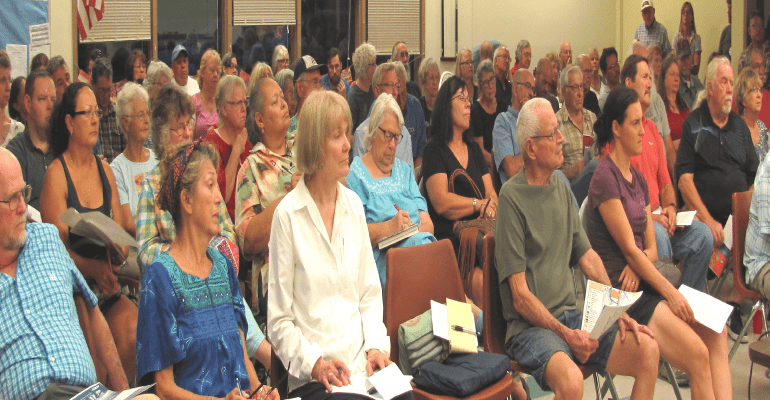
It was standing room only as over 100 area residents crowded into the Picture Rocks Community Center August 21 for the month’s regular Citizens for Picture Rocks (C4PR) meeting. The guest speaker was Jay Van Echo, Study Manager for the Arizona Department of Transportation (ADOT) and Federal Highway Administration’s (FWHA) Interstate 11 Tier One Environmental Impact Statement. The $15 million study, in its second year, has narrowed its choices to either a new Avra Valley highway, which would impact some 25,000 people living in the Avra Valley, or working within the existing Interstate 10 corridor with widening or double decking small portions. There is also a rarely invoked No Build option.
With Van Echo were FHWA Deputy Aryan Lirange and ADOT press agent Laura Douglas. An invitation had been accepted for Van Echo to speak at a C4PR meeting exactly one year ago, but the Study Manager bailed out at the last minute. Unlike the ADOT/FHWA public meetings where no discussion or questions were allowed from the floor, C4PR President Della Grove had a list of prepared questions and accepted questions and comments from the audience, asking only that they use the microphone so everyone could hear them, and that they be respectful.
Van Echo began with a history of the I-11 study, citing talk of a “Canamex Corridor” going back to 1991, followed by NAFTA in 1994, through the 2015 FAST Act where Arizona Senator John McCain’s pro-I-11 amendment was added. No funding has yet been identified for I-11 in Arizona. The ADOT representative stressed that the Tier One Study was “a deliberative document and not a decision document.” It is no secret that ADOT and FHWA have favored an Avra Valley route from the beginning.

They expect to announce a “preferred alternative” by the end of the year and will then move into how to make that choice work. A Tier 2 study would then work on specific alignments within the chosen corridor, working within a 400-foot right-of-way instead of a 2000-foot corridor. One problem is that there is only an 80-foot right-of-way in the Mile Wide-Sandario area, with the Tohono O’odham’s Garcia Strip on one side and the Federal Bureau of Reclamation‘s Wildlife Mitigation Corridor on the other. That corridor was established “in perpetuity” when the CAP canal was built. Van Echo said they were meeting with both parties “to see what we can work out”.
There were many questions and comments, all respectful and all clearly opposed to I-11 coming through the Avra Valley. Concerns covered air, water and light pollution, creation of a new Valley Fever corridor, exporting jobs to Mexico contrary to national policy, wildlife movement, loss of jobs in the I-10 corridor, increased smuggling, and “conspiracy and collusion” between the I-11 planners and Pima County.
That concern was bolstered by citing the county administrator’s support for an Avra Valley I-11 in direct violation of the Board of Supervisors resolution, by some 1500 acres along the “Huckelberry Highway” being owned by Cardon family businesses, by Diamond Ventures getting a free access highway, renamed the “Sonoran Corridor,” for a planned Swan Southlands development and Don Diamond being on the late Wil Cardon’s campaign committee as well as raising thousands of dollars for Supervisor Sharon Bronson’s last election, and by reports that land owners in the Avra Valley I-11 path were seeing assessed valuations going down while others went up, presumably to save the county money when eviction time comes. District 3 resident JoAnn di Filippo, who owns a horse ranch south of Picture Rocks, said those reports had been verified.
Van Echo avoided some, said others would be addressed in the forthcoming document, and attempted to joke off others. One of Van Echo’s slides showed projected increases in travel time along the Wickenburg-Nogales route. It was noted that, by 2040, travel time from Tucson to Nogales could increase as much as two minutes. That was duly noted by audience members.
[caption id="attachment_160629" align="aligncenter" width="770"] Avra Valley Coalition activists Jo Bowman (standing), Paul Hamilton and Robin Clark asked about maps showing the properties that would be affected. After waffling, Van Echo said the maps would be available in December.
Avra Valley Coalition activists Jo Bowman (standing), Paul Hamilton and Robin Clark asked about maps showing the properties that would be affected. After waffling, Van Echo said the maps would be available in December.
When told that County Administrator Charles Huckelberry’s plan for I-11 called for the eviction of 47 families, Van Echo quipped that they would be “impacted, not evicted…it depends on whether you have a motivated buyer or a motivated seller.” Asked about the President’s goals to bring jobs back to America and I-11’s Business Case to attract jobs to Mexico, the Study Manager said that “Mexico is America’s number one trade partner…if there’s a wall, there will be gates.” He added that ADOT was working with Mexican planners. But Van Echo “could not recall” when asked about the City of Tucson’s position on I-11 but remembered after being prompted that Tucson supported improving the I-10 corridor and had concerns about potential CAP settling pond pollution.
When asked if the Study Team would pay attention to the “thousands of comments” opposing I-11 in the Avra Valley, if there was a threshold for making decisions, he said, “No…all voices are equal.” In fact, 89 percent of over 3000 comments opposed an Avra Valley I-11, with only ½ of one percent in favor.
With the “preferred alternative” to be announced by the end of the year, there will be a series of public meetings likely in January, and will include Tucson and Marana locations. Van Echo agreed to open them up to public questions and comments rather than a speech followed by one-on-one comments to staff. He also agreed to seek better days and times so that more people could participate. A final decision will be made by the federal government after studies are completed. He said also that “there’s no definite plan at this stage…we don’t build roads if they’re not really needed.” The audience groaned in disbelief.

Citizens for Picture Rocks, a 17-year-old 501 (c) (4) community group, had complained to the planners about not being invited to a recent series of “Stakeholder Engagement Meetings” which many saw as a ploy to make the 89 percent and the ½ of one percent somehow equal, but which came out instead with a strong statement opposing an Avra Valley I-11 and calling for improvements on I-10. Van Echo said the invitation had been sent to Pamela Moseley, former C4PR president. Moseley, a Pima County employee, said she had no memory of ever receiving such an invitation.
For I-11 study reports, summaries and raw documents, visit i11study.com/Arizona. Comments may be submitted at any time.
